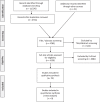Laminopathies' Treatments Systematic Review: A Contribution Towards a 'Treatabolome'
- PMID: 33682723
- PMCID: PMC8203247
- DOI: 10.3233/JND-200596
Laminopathies' Treatments Systematic Review: A Contribution Towards a 'Treatabolome'
Abstract
Background: Variants in the LMNA gene, encoding lamins A/C, are responsible for a growing number of diseases, all of which complying with the definition of rare diseases. LMNA-related disorders have a varied phenotypic expression with more than 15 syndromes described, belonging to five phenotypic groups: Muscular Dystrophies, Neuropathies, Cardiomyopathies, Lipodystrophies and Progeroid Syndromes. Overlapping phenotypes are also reported. Linking gene and variants with phenotypic expression, disease mechanisms, and corresponding treatments is particularly challenging in laminopathies. Treatment recommendations are limited, and very few are variant-based.
Objective: The Treatabolome initiative aims to provide a shareable dataset of existing variant-specific treatment for rare diseases within the Solve-RD EU project. As part of this project, we gathered evidence of specific treatments for laminopathies via a systematic literature review adopting the FAIR (Findable, Accessible, Interoperable, and Reusable) guidelines for scientific data production.
Methods: Treatments for LMNA-related conditions were systematically collected from MEDLINE and Embase bibliographic databases and clinical trial registries (Cochrane Central Registry of Controlled Trials, clinicaltrial.gov and EudraCT). Two investigators extracted and analyzed the literature data independently. The included papers were assessed using the Oxford Centre for Evidence-Based Medicine 2011 Levels of Evidence.
Results: From the 4783 selected articles by a systematic approach, we identified 78 papers for our final analysis that corresponded to the profile of data defined in the inclusion and exclusion criteria. These papers include 2 guidelines/consensus papers, 4 meta-analyses, 14 single-arm trials, 15 case series, 13 cohort studies, 21 case reports, 8 expert reviews and 1 expert opinion. The treatments were summarized electronically according to significant phenome-genome associations. The specificity of treatments according to the different laminopathic phenotypical presentations is variable.
Conclusions: We have extracted Treatabolome-worthy treatment recommendations for patients with different forms of laminopathies based on significant phenome-genome parings. This dataset will be available on the Treatabolome website and, through interoperability, on genetic diagnosis and treatment support tools like the RD-Connect's Genome Phenome Analysis Platform.
Keywords: LMNA gene; Lamin A/C; Treatabolome; cardiomyopathy; laminopathies; lipodystrophies; muscular dystrophy; progeria; sudden cardiac death.
Conflict of interest statement
None to declare.
Figures
References
-
- Bonne G, Quijano-Roy S. Chapter 142 - Emery–Dreifuss muscular dystrophy, laminopathies, and other nuclear envelopathies. In: Dulac O, Lassonde M, Sarnat HB, editors. Handbook of Clinical Neurology. 113: Elsevier; 2013. pp. 1367-76. - PubMed
Publication types
MeSH terms
Substances
LinkOut - more resources
Full Text Sources
Other Literature Sources
Research Materials
Miscellaneous


